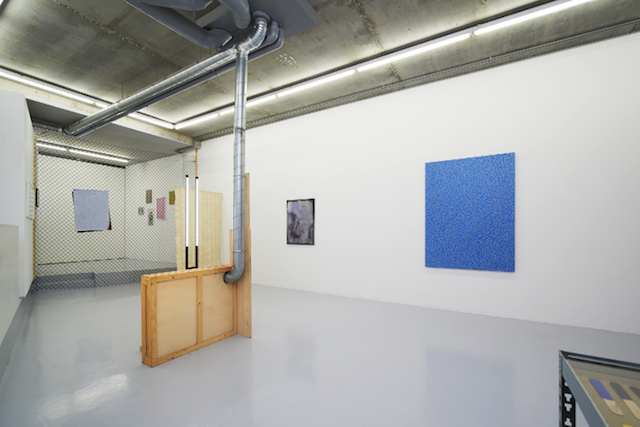Galerie Martin van Zomeren, Amsterdam, 15 April – 20 May
According to Navid Nuur, the largest mono-chrome in the world is the one we see when we close our eyes. Ever since he was a child, the Dutch-Iranian artist has been trying to work out what he sees under such circumstances, and all his ‘paintings’ – made in an array of formats, colours, materials, not all involving paint – are attempts to represent it. His latest work in this longstanding series, collectively entitled The Eye-Codex of the Monochrome (1984–), is brought together in Sandman’s Sand, an exhibition as engaging as it is intriguing.
When all visual stimuli are cut off, what are we left looking at? Personally, in this condition I don’t see much more than darkness, with some blurry spots that I assume are afterimages on my retina. But Nuur, an expert at staring into nothingness, sees endless patterns of innumerable irregular dots – a kind of boundless mesh that seems to slide past almost imperceptibly, flickering softly. Maybe you’ve seen it yourself at some point when you were on the verge of waking up.
Nuur’s fascination with ‘seeing nothing’ is, naturally, the show’s red thread. In the middle of the gallery sits a shipping crate fitted with a flue connected to the ventilation system on the ceiling. Two metal tubes at the base serve as stoking channels. By setting off two emergency flares inside these tubes, a painting has been ‘smoked’ inside the crate, like a mackerel. The sooty, sweaty canvas hangs next to its packaging – the result of a fascinating attempt to make a painting ‘blind’ (Aladin, 2010–17).
City Silence ii (2011–17) draws on what you could call a ‘blinding’ technique, derived from the world of graphics. Posters tend to have what’s known as a ‘blue back’: a layer of blue ink that prevents whatever’s underneath showing through. Nuur has photographed this, printed it on poster paper and pasted the latter onto a chain-link fence that partitions the gallery space, so that something normally intended to conceal is itself revealed. A similar idea informs The Eye-Codex of the Monochrome (STUDY) (2011–17). Envelopes have been unfolded to expose the pattern printed on the inside to prevent the contents from showing through, and the different patterns of dots bear a remarkable resemblance to what Nuur sees with his eyes closed.
Peering into darkness, sooner or later perception will morph into imagination. The Passage (2017), a photograph of a cave printed on a gold foil emergency blanket, may be a nod to the dark hole that Alice fell down to get to Wonderland. Another photograph shows the artist attempting to step into a black circle painted onto the wall of his studio (Another window in my studio, 2008–2017). The cave and black hole both recall the pupil of the eye that turns up in several photographic works – all openings onto the invisible boundary between the world inside and the world outside.
That Nuur, with these clever conceptual sleights of hand, is setting himself apart from conventional painting practice is clearly apparent from the cabinet of materials that forms part of the exhibition. The metal shelves aren’t stacked with the usual tubes of oil paint or tins of acrylics but rather with tins of bitumen, gesso and antirust varnish – substances manufactured to fulfil a certain function, not to give a certain shade. Yet these supposedly neutral colours, too, inevitably evoke associations. Study 4–87 (The Eye-Codex of the Monochrome) (1984–2017), painted with swimming-pool paint, is suggestive of an endless surface of water; Study 93 (The Eye-Codex of the Monochrome) (1984–2017) is made of the reflector foil used in traffic signs, illuminated by two lamps so that it glints like the canopy of the night sky full of stars. Light, essential for seeing any painting, here seems to spring from the surface of the work itself. In such works, as elsewhere, Nuur crosses the alchemy of painting with the phenomenology of perception. He, then, is the sandman of the exhibition title: a sandman who, paradoxically, creates new images by taking away sight.
First published in the Summer 2017 issue of ArtReview
